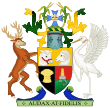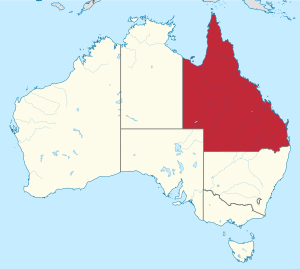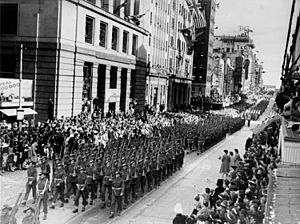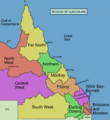Queensland facts for kids
Quick facts for kids
Queensland
|
|||
|---|---|---|---|
|
|||
| Nickname(s):
The Sunshine State · Beautiful One Day, Perfect the Next
|
|||
| Motto: | |||
|
Location of Queensland in Australia
|
|||
| Country | Australia | ||
| Before federation | Colony of Queensland | ||
| Separation from New South Wales | 6 June 1859 | ||
| Federation | 1 January 1901 | ||
| Named for | Queen Victoria | ||
| Capital
and largest city
|
Brisbane 27°28′08″S 153°1′25″E / 27.46889°S 153.02361°E |
||
| Administration | 77 local government areas | ||
| Demonym(s) | Queenslander | ||
| Government | |||
|
• Monarch
|
Charles III | ||
|
• Governor
|
Jeannette Young | ||
|
• Premier
|
Steven Miles (Labor) | ||
| Legislature | Parliament of Queensland | ||
| Parliament of the Commonwealth | |||
|
• Senate
|
12 senators (of 76) | ||
| 30 seats (of 151) | |||
| Area | |||
|
• Land
|
1,723,030 km2 (665,270 sq mi) | ||
| Highest elevation | 1,622 m (5,322 ft) | ||
| Population | |||
|
• Estimate
|
5,556,682 | ||
| GDP (nominal) | 2020 estimate | ||
|
• Per capita
|
$70,862 (5th) | ||
| HDI (2021) | very high · 5th |
||
| Time zone | UTC+10:00 (AEST) | ||
| Postal abbreviation |
QLD
|
||
| ISO 3166 code | AU–QLD | ||
| Symbols | |||
| Mammal | Koala (Phascolarctos cinereus) | ||
| Bird | Brolga (Grus rubicunda) | ||
| Fish | Barrier Reef Anemone Fish (Amphiprion akindynos) |
||
| Flower | Cooktown orchid (Dendrobium phalaenopsis) |
||
| Fossil | Muttaburrasaurus langdoni | ||
| Mineral | Sapphire | ||
| Colour | Maroon | ||
Queensland (often called Qld) is a large state in northeastern Australia. It is the second-largest state by land area and the third-largest by population. Queensland shares borders with the Northern Territory, South Australia, and New South Wales. To the east, it meets the Coral Sea and the Pacific Ocean. To the north, the Torres Strait separates it from Papua New Guinea, and the Gulf of Carpentaria is to the northwest.
Queensland is huge, covering about 1.7 million square kilometers. This makes it one of the largest subnational areas in the world. Because of its size, Queensland has many different landscapes and climates. You can find tropical rainforests, rivers, amazing coral reefs, mountain ranges, and sandy beaches. Its coastal areas are tropical or subtropical. Further inland, you'll find deserts and savanna with drier climates.
More than 5.5 million people live in Queensland. Most of them live along the east coast, especially in the southeast. The capital and biggest city is Brisbane, which is Australia's third-largest city. Many other large Australian cities are in Queensland, like the Gold Coast, Sunshine Coast, Townsville, Cairns, Ipswich, and Toowoomba. About 28.9% of the people living in Queensland were born in other countries.
Queensland was first home to Aboriginal Australians and Torres Strait Islanders. The first European to visit was Dutch explorer Willem Janszoon in 1606. Later, in 1770, James Cook claimed the east coast for Great Britain. In 1788, the colony of New South Wales was started, which included what is now Queensland. Over time, more Europeans explored the area. A settlement for convicts was set up in Brisbane in 1824. During the 1800s, there were many conflicts between European settlers and Aboriginal people.
On June 6, 1859, Queen Victoria officially made Queensland a separate colony from New South Wales. This day is now celebrated as Queensland Day. In the early days of the colony, many people from the South Sea Islands were brought to Queensland to work on farms. This was often done against their will.
Queensland was one of the six colonies that joined together to form Australia on January 1, 1901. This is known as Federation. Since the late 1900s, many people from other parts of Australia have moved to Queensland. It remains a very popular place to live.
Queensland has the third-largest economy among Australian states. Its main industries include mining, farming, transport, and tourism. It's often called the Sunshine State because of its warm climate, the Great Barrier Reef, and its many beautiful beaches. Tourism is a very important part of Queensland's economy.
Contents
Exploring Queensland's Past: A Look at Its History
Ancient Times: Before European Arrival
Queensland had one of the largest Aboriginal populations in Australia before Europeans arrived. It is believed that Aboriginal people lived in Queensland over 50,000 years ago. They likely arrived by boat or a land bridge from the Torres Strait. Over time, they formed more than 90 different language groups.
During the last ice age, Queensland became very dry. Food and supplies were hard to find. This led to the development of the world's first seed-grinding tools. After the ice age, the climate became warmer and wetter, especially along the east coast. This helped the state's tropical rainforests grow.
The Torres Strait Islands are home to the Torres Strait Islander peoples. These people have their own unique culture and history. They are different from mainland Aboriginal peoples. They have long had connections with both Aboriginal people and the people of New Guinea.
European Settlers Arrive in Queensland
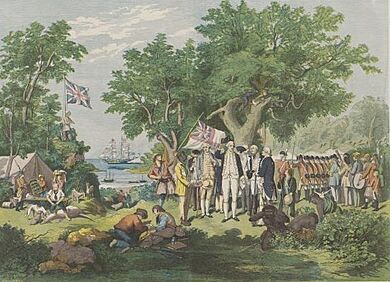
In February 1606, Dutch explorer Willem Janszoon landed near Weipa. This was the first time a European was recorded landing in Australia. It was also the first known meeting between Europeans and Aboriginal people of Australia. Other European explorers from France and Spain also visited the area. Then, in 1770, Lieutenant James Cook arrived. He claimed the east coast for Great Britain, naming it New South Wales. This included the land that is now Queensland.
Sadly, the Aboriginal population decreased a lot after a smallpox epidemic in the late 1700s. There were also many conflicts with European settlers.
In 1823, British explorer John Oxley looked for places to set up new settlements. He found the Brisbane River in Moreton Bay. In 1824, he started a penal settlement (a place for convicts) at Redcliffe. This settlement later moved to the center of Brisbane. In 1839, the use of convicts stopped. Free settlers were officially allowed to move to Queensland in 1842.
The first ship carrying free immigrants from Europe arrived in Moreton Bay in 1848. It was called the Artemisia. Before this, some Irish orphan girls arrived in 1848 on the ship Ann Mary. They were part of a plan to help poor girls from Ireland.
Queensland Becomes Its Own Colony
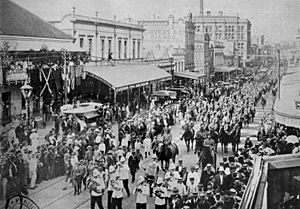
In 1851, people started discussing Queensland becoming separate from New South Wales. On June 6, 1859, Queen Victoria signed the papers to create the separate colony of Queensland. This made Queensland a self-governing colony with its own government. Brisbane was chosen as the capital city. On December 10, 1859, George Bowen, the first Governor of Queensland, officially announced Queensland as a separate colony. The first election was held in 1860, and Robert Herbert became the first Premier of Queensland.
In 1865, Queensland's first railway line opened between Ipswich and Grandchester. The economy grew quickly in 1867 when gold was found near Gympie. This started a gold rush, though it was smaller than those in other states.
From the 1860s to the early 1900s, many workers from Pacific Island nations were brought to Queensland. They were called Kanakas and worked in the sugar cane fields. Some of these people were forced to come. Their working conditions were often very unfair. Later, Italian immigrants also joined the sugar cane industry.
In the 1890s, the six Australian colonies, including Queensland, decided to join together. This led to the Federation of Australia on January 1, 1901. At this time, Queensland had about half a million people. Since then, Queensland has been a state within Australia, and its population has grown a lot.
Queensland in the 20th Century
In 1905, women in Queensland voted in state elections for the first time. The state's first university, the University of Queensland, opened in Brisbane in 1909. In 1911, new treatments for polio were developed in Queensland. These treatments are still used around the world today.
World War I had a big impact on Queensland. Over 58,000 Queenslanders fought in the war, and more than 10,000 of them died.
Australia's first major airline, Qantas, was started in Winton in 1920. Its name originally stood for "Queensland and Northern Territory Aerial Services."
In 1922, Queensland changed its government system. It became the only Australian state with a single house of parliament, called a unicameral parliament.
In 1935, cane toads were brought to Queensland from Hawaii. This was an attempt to control beetles that were harming sugar cane plants. However, the toads became a pest themselves and are still an environmental problem today. In 1962, oil was first produced commercially in Queensland at Moonie.
During World War II, Brisbane became an important center for the Allied forces. General Douglas MacArthur, the leader of the Allied Pacific forces, had his headquarters in Brisbane. In 1942, there was a conflict between US military personnel and Australian servicemen and civilians in Brisbane, known as the Battle of Brisbane.
After World War II, many people from Europe moved to Queensland. In the later part of the 20th century, Queensland became a popular place for people from other Australian states to move to, partly because of its warm climate and the invention of air conditioning.
In 1981, the Great Barrier Reef, one of the world's largest coral reef systems, was named a UNESCO World Heritage Site.
Queensland in the 21st Century
In 2003, maroon was officially chosen as Queensland's state color. This was because it had been used for many years to represent Queensland in sports.
Between late 2010 and early 2011, Queensland experienced major floods. These floods caused a lot of damage across the state.
In 2020, Queensland was affected by the COVID-19 pandemic. Even though there were not many cases, rules like social distancing and border closures were put in place.
Queensland's Diverse Landscapes and Climate
Geographical Features of Queensland

Queensland is a very large state, covering over 1.7 million square kilometers. If it were a country, it would be the 16th largest in the world! This huge size means it has many different climates and types of land.
Queensland's eastern coast is next to the Coral Sea, which is part of the Pacific Ocean. To the north, the Torres Strait separates Queensland from New Guinea. The Cape York Peninsula points towards New Guinea and is the northernmost part of the state. To the west of this peninsula is the Gulf of Carpentaria. Queensland shares its western border with the Northern Territory and its southwestern border with South Australia. The southern border with New South Wales follows rivers and a line of latitude.
Like much of eastern Australia, the Great Dividing Range runs roughly parallel to the coast. Areas to the west of this mountain range are drier than the humid coastal regions. The Great Barrier Reef, the world's largest coral reef system, runs along Queensland's Coral Sea coast. Queensland's coastline also has the world's three largest sand islands: K'gari (Fraser Island), Moreton, and North Stradbroke.
Queensland has six areas that are listed as World Heritage Sites. These include the Great Barrier Reef, K'gari (Fraser Island), the wet tropics (like the Daintree Rainforest), Lamington National Park, the Riversleigh fossil sites, and the Gondwana Rainforests.
Understanding Queensland's Climate Zones

Queensland's large size means its climate changes a lot from one area to another. The coastline gets plenty of rain. The tropical north has a monsoonal wet season, while the southern coast has humid sub-tropical conditions. Inland and western areas typically have low rainfall and hot, humid summers. Higher areas in the southeastern inland can get very cold in winter, with frost and even rare snowfall. The warm ocean waters influence the coastal climate, keeping temperatures mild and providing moisture for rain.
Queensland has six main climate zones based on temperature and humidity:
- Hot and humid all year (far north and coast): Like Cairns and Innisfail.
- Hot, humid summers; warm, dry winters (north and coast): Such as Townsville and Mackay.
- Hot, humid summers; mild, dry winters (coastal elevated areas and southeast coast): Includes Brisbane, Bundaberg, and Rockhampton.
- Hot, dry summers; mild, dry winters (central inland and northwest): Like Mt Isa, Emerald, and Longreach.
- Hot, dry summers; cool, dry winters (southern inland): For example, Roma, Charleville, and Goondiwindi.
- Warm, humid summers; cold, dry winters (elevated southeastern areas): Such as Toowoomba, Warwick, and Stanthorpe.
The far north coast of Queensland is the wettest part of Australia. Mount Bellenden Ker, south of Cairns, gets over 8 meters of rain each year! Snow is rare in Queensland, but it does fall sometimes along the southern border with New South Wales, especially in the Stanthorpe area.
Queensland can experience natural disasters. Strong tropical cyclones can hit the central and northern coasts, causing a lot of damage. Flooding from heavy rain can happen anywhere in Queensland. Severe thunderstorms, which can bring strong winds, heavy rain, large hail, and even tornadoes, usually affect the southeast and inland areas. The strongest tornado ever recorded in Australia happened in Queensland near Bundaberg in 1992. Bushfires and droughts can also occur.
The highest temperature ever recorded in Queensland was 49.5°C at Birdsville on December 24, 1972. The lowest temperature recorded was -10.6°C at Stanthorpe in 1961 and at The Hermitage in 1965.
People and Culture in Queensland
Who Lives in Queensland?

In December 2021, Queensland had an estimated population of over 5.2 million people. About half of the state's population lives in Brisbane. More than 70% live in South East Queensland. Queensland is the second most spread-out state in Australia after Tasmania. Since the 1980s, Queensland has been one of the fastest-growing states in Australia. Many people move there from other countries and from other Australian states.
Major Cities in Queensland
Ten of Australia's thirty largest cities are located in Queensland. In 2019, the biggest cities by population were:
- Brisbane: 2,514,184 people
- Gold Coast–Tweed Heads: 693,671 people
- Sunshine Coast: 341,069 people
- Townsville: 181,668 people
- Cairns: 153,951 people
- Toowoomba: 138,223 people
- Mackay: 80,264 people
- Rockhampton: 79,081 people
- Bundaberg: 71,309 people
- Hervey Bay: 55,345 people
- Gladstone–Tannum Sands: 45,631 people
Backgrounds of Queenslanders
Early settlers in the 1800s mostly came from England, Ireland, Scotland, and Germany. After World War II, many immigrants arrived from southern and eastern Europe, especially Italy. In the 21st century, most new immigrants come from Asia, particularly China and India.
In 2016, the most common backgrounds people identified with were:
- English (41.3%)
- Australian (37.9%)
- Irish (13%)
- Scottish (11.2%)
- German (6.8%)
- Indigenous (4%)
- Chinese (3.1%)
- Italian (3%)
- Indian (1.7%)
- Dutch (1.6%)
- New Zealander (1.6%)
- Maori (1.2%)
- Filipino (1.2%)
The 2016 census showed that 28.9% of people in Queensland were born overseas. Only 54.8% had both parents born in Australia. The most common birthplaces for people born overseas were New Zealand, England, India, China, and South Africa.
In 2016, 4% of the population, or 186,482 people, identified as Indigenous Australians (Aboriginal Australians and Torres Strait Islanders).
Languages Spoken in Queensland
In 2016, 81.2% of people in Queensland spoke only English at home. Other common languages included Mandarin (1.5%), Vietnamese (0.6%), Cantonese (0.5%), Spanish (0.4%), and Italian (0.4%).
By 2021, 80.5% spoke only English at home. Mandarin (1.6%), Vietnamese (0.6%), Punjabi (0.6%), and Spanish (0.6%) were the next most common languages.
Beliefs and Religions
In 2016, the most common religious affiliations were 'No religion' (29.2%), Catholicism (21.7%), and Anglicanism (15.3%).
By 2021, 45.7% of the population followed Christianity. 41.2% said they had No religion. About 5% of people followed a non-Christian religion, mainly Buddhism (1.4%), Hinduism (1.3%), and Islam (1.2%).
Learning and Education in Queensland
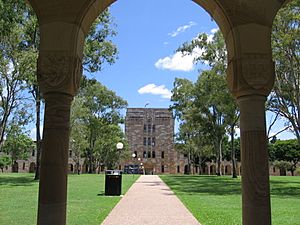
Queensland has many universities. The oldest, the University of Queensland, was founded in 1909. It often ranks among the world's top 50 universities. Other major universities include Queensland University of Technology, Griffith University, and James Cook University. Bond University was Australia's first private university.
Teaching international students is a big industry in Queensland. In 2018, 134,312 international students were studying in the state, mostly in Brisbane. Most of these students come from Asia.
For younger students, Queensland has many state (public) and private schools.
Queensland also has a public library system managed by the State Library of Queensland. Some university libraries are also open to the public.
Queensland's Economy and Tourism
How Queensland Makes Money
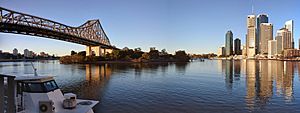
In 2019, Queensland's economy was worth A$357,044 million. This was the third-highest among Australian states. In the 1800s, building sea ports and railways helped Queensland become good at exporting goods from mining and farming. Since the 1980s, many people moving to Queensland, government investments, and more mining have helped the economy grow.
Queensland's main primary industries include bananas, pineapples, peanuts, many other fruits and vegetables, grain, wine, cattle, cotton, sugarcane, and wool. The mining industry produces bauxite, coal, silver, lead, zinc, gold, and copper.
Secondary industries mostly involve processing these raw materials. For example, bauxite from Weipa is turned into alumina at Gladstone. There is also copper refining and sugar refining from sugar cane.
Major service industries include retail, tourism, and international education. In 2018, over 134,000 international students were studying in Queensland, mostly in Brisbane. Most of them came from Asia.
Brisbane is considered a global city and has one of the largest economies in the Asia-Pacific region. It is strong in mining, banking, insurance, transport, and technology. Many large Australian companies have their main offices in Brisbane.
Exploring Queensland: Top Tourist Spots

Tourism is Queensland's biggest service industry. Millions of visitors from Australia and other countries come to Queensland every year. This industry brings in $8.8 billion annually and supports many jobs.
The most popular places to visit in Queensland include Brisbane (and nearby islands like Moreton and South Stradbroke), the Sunshine Coast, the Great Barrier Reef, Cairns, Port Douglas, the Daintree Rainforest, K'gari, and the Whitsunday Islands.
Brisbane is the third most popular city for tourists in Australia. In Brisbane, you can visit South Bank Parklands, the Queensland Cultural Centre (with museums and art galleries), City Hall, the Story Bridge, and the Brisbane River with its ferry services. You can also see koalas at the Lone Pine Koala Sanctuary.
The Gold Coast is famous for its surf beaches like Surfers Paradise. It also has the most amusement parks in Australia, including Dreamworld and Movie World. The Gold Coast's hinterland (the area behind the coast) includes Lamington National Park.
The Sunshine Coast has popular beaches like Noosa Heads. It is also home to UnderWater World and Steve Irwin's Australia Zoo. The hinterland features the Glass House Mountains National Park.
Cairns is known as the gateway to the Great Barrier Reef, the northern parts of Queensland, and the Daintree Rainforest. The Whitsunday Islands are a popular place for resorts and for visiting the Great Barrier Reef.
Queensland's Culture and Sports
Arts and Events in Queensland
Queensland has major art galleries like the Queensland Art Gallery and the Queensland Gallery of Modern Art. It also has cultural groups such as the Queensland Ballet and the Queensland Symphony Orchestra, all based in Brisbane. Famous musicians from Queensland include the Bee Gees and Savage Garden.
Big annual cultural events include the Royal Queensland Exhibition, an agricultural show held every August in Brisbane. The Brisbane Festival in September includes 'Riverfire', one of Australia's largest fireworks displays.
Sports in Queensland
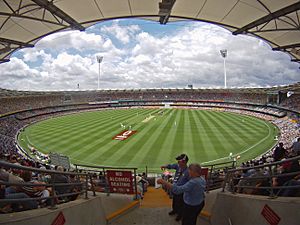
Queensland has teams in all of Australia's national sports competitions. It also hosts many local and international sporting events. The most popular team sports are rugby league in winter and cricket in summer.
In the National Rugby League, Queensland has teams like the Brisbane Broncos and North Queensland Cowboys. The annual State of Origin series in rugby league is a huge event, with the Queensland Maroons representing the state.
In cricket, the Queensland Bulls play in national competitions, and the Brisbane Heat compete in the Big Bash League.
Queensland also has teams in Australian Football League (AFL), like the Brisbane Lions, and in soccer (football), like the Brisbane Roar FC. In netball, the Queensland Firebirds are a successful team. Basketball teams include the Brisbane Bullets.
Swimming is also very popular in Queensland. Many Australian Olympic swimmers and international medalists come from the state.
Brisbane will host the 2032 Summer Olympics. This will be the third time Australia has hosted the Olympic Games.
Symbols and Emblems of Queensland
Queensland has official state symbols. These are set out in the Emblems of Queensland Act 2005.
Queen Victoria gave Queensland its Coat of Arms in 1893. It is the oldest State Arms in Australia. It shows Queensland's main industries from the 1800s, like wheat, cattle, and gold. It also has sugar cane stalks and the state motto, Audax at Fidelis, which means "Bold but Faithful." In 1977, Queen Elizabeth II added the brolga (a bird) and the red deer as supporting animals.
In November 2003, maroon was officially named Queensland's state color. This was because it had been used for many years by Queensland sports teams.
The koala became Queensland's official animal emblem in 1971. The brolga was named the official bird emblem in 1986.
The Cooktown orchid became Queensland's floral emblem in 1959. The Barrier Reef Anemone Fish was named Queensland's aquatic emblem in 2005.
The sapphire was named the official state gem for Queensland in August 1985.
Getting Around: Queensland's Transport and Services
Transportation in Queensland
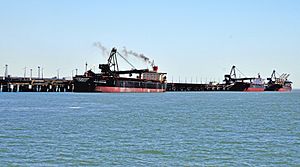
Queensland has several National Highways and freeways, especially in South East Queensland. The Department of Transport & Main Roads manages roads and public transport.
Train services are mainly provided by Queensland Rail. They connect major towns east of the Great Dividing Range. Freight trains are run by companies like Aurizon. Major seaports include the Port of Brisbane, which is Australia's third busiest. Other important ports are at Gladstone, Townsville, and Bundaberg. There are also large facilities for exporting coal and sugar.
Brisbane Airport is the main airport for international and domestic flights in Queensland. It is Australia's third busiest airport. Other international airports include the Gold Coast Airport and Cairns International Airport. There are also many regional airports with domestic flights.
South East Queensland has an integrated public transport system called Translink. It includes buses, trains, light rail, and ferries in Brisbane. The train network has 152 stations across 13 lines. Brisbane also has a large bus network and popular ferry services on the Brisbane River. The G:link is Queensland's only light rail network, located on the Gold Coast.
The new Queensland Cross River Rail is a metro network being built in Brisbane. It is an important project to prepare the city for the 2032 Olympic Games. This new rail system will make travel faster and easier within Brisbane. It will use modern electric trains to connect the north and south sides of the city. This project aims to improve how people move around Brisbane, reduce traffic, and make the city more accessible for everyone.
Other Important Services
Queensland Health runs the state's public health system. There are sixteen regional Health and Hospital Services that provide public health care. Major public hospitals include the Royal Brisbane and Women's Hospital and the Queensland Children's Hospital in Brisbane. There are also large hospitals in regional cities like Townsville and Cairns. Many smaller public and private hospitals are located throughout the state.
Images for kids
See also
 In Spanish: Queensland para niños
In Spanish: Queensland para niños



